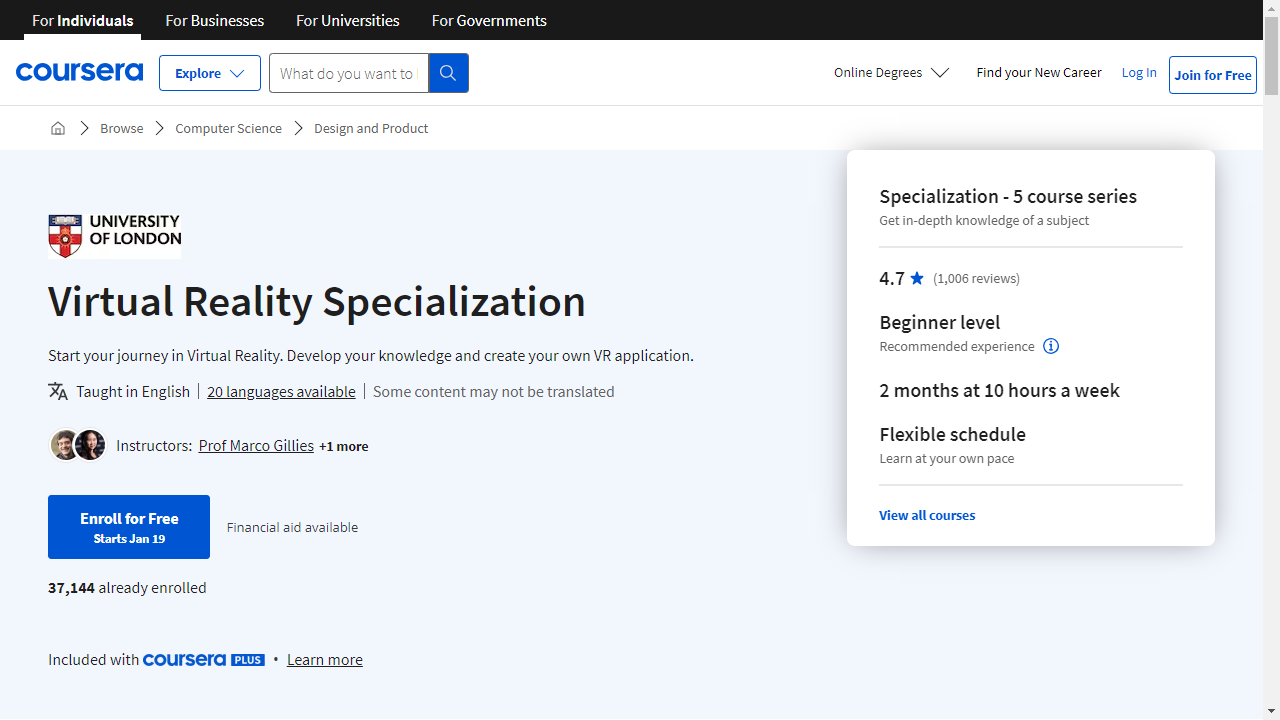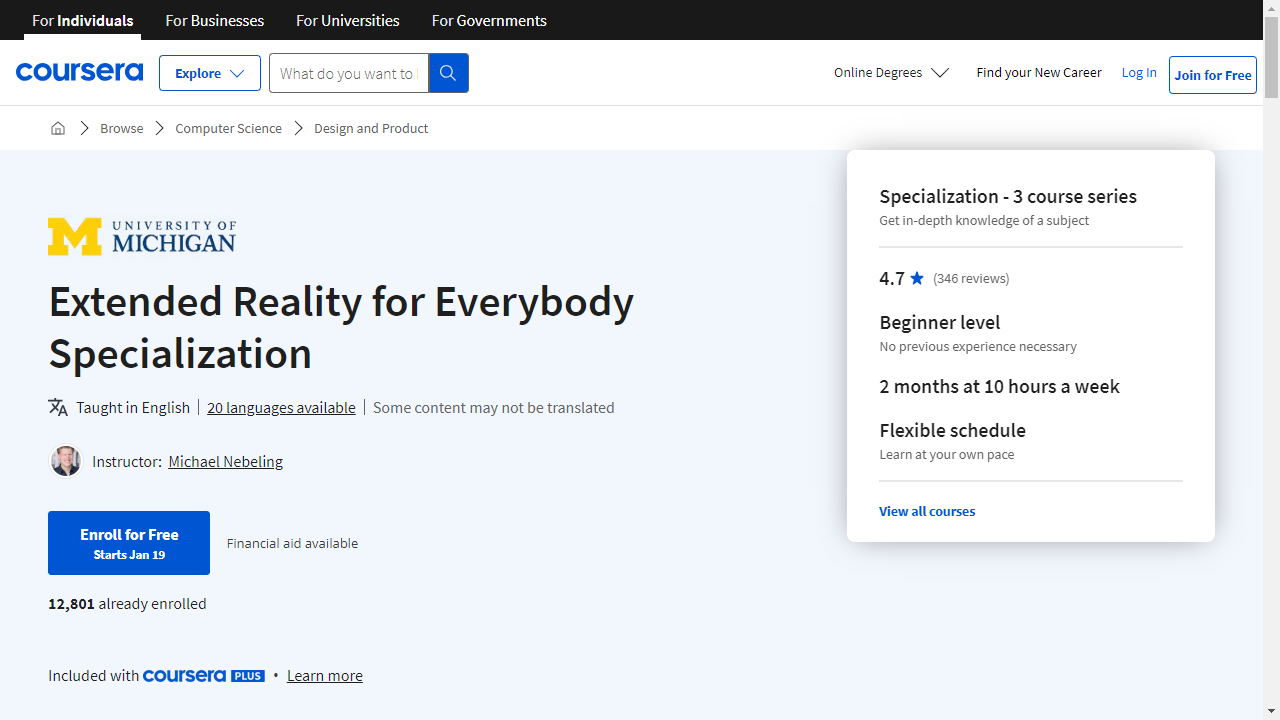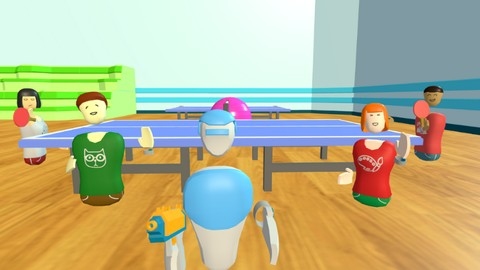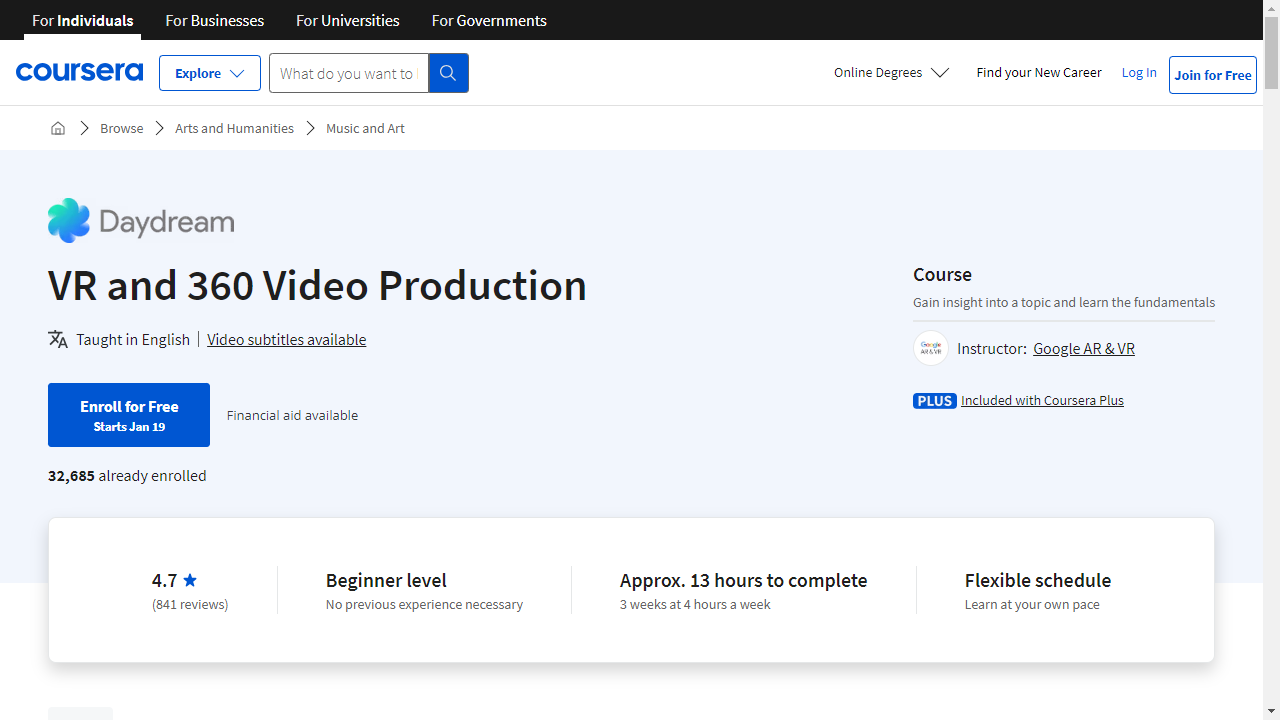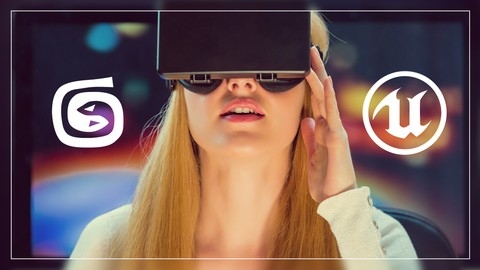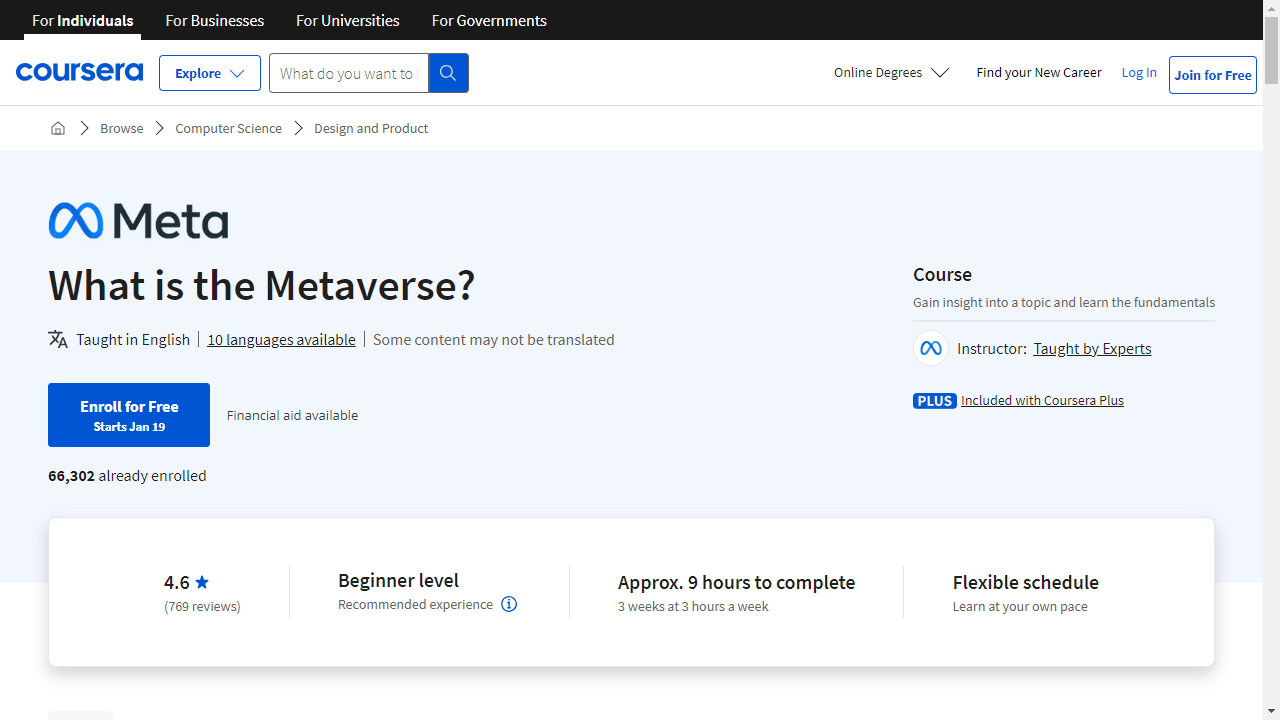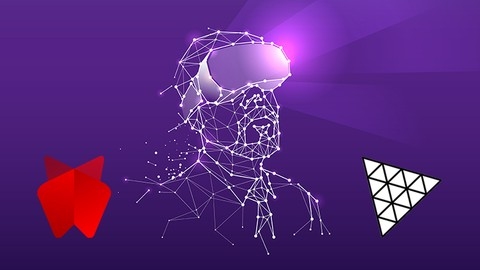Virtual Reality (VR) is rapidly transforming how we interact with the digital world, offering immersive experiences in gaming, entertainment, education, and even healthcare.
By learning VR development, you can unlock exciting career opportunities and contribute to shaping the future of this dynamic field.
Whether you aspire to create interactive games, design training simulations, or build virtual worlds, acquiring VR skills empowers you to bring your creative visions to life.
Finding the ideal virtual reality course can be challenging, given the abundance of options available.
You’re searching for a comprehensive program that covers both theoretical foundations and practical skills, taught by experienced instructors who can guide you through the complexities of VR development.
For the best virtual reality course overall, we recommend the Virtual Reality Specialization on Coursera.
This comprehensive program delves deep into VR design and development, covering everything from the history and psychology of VR to 3D graphics, audio design, and social VR interactions.
You’ll even gain hands-on experience by developing a complete VR game from concept to completion.
While the Virtual Reality Specialization is our top pick, we understand that learners have diverse needs and preferences.
To cater to this, we’ve explored a range of other VR courses, each with its own unique strengths and focus areas.
Virtual Reality Specialization
Provider: Coursera
This Coursera specialization equips you with the skills to design and develop your own immersive VR experiences.
You’ll begin with the fundamentals, exploring the history of VR and examining popular hardware like Oculus Rift and HTC Vive.
You’ll then delve into the psychology behind VR, understanding how to craft truly engaging experiences.
The curriculum then guides you through the technical aspects of VR development.
You’ll master 3D graphics, learning how to create realistic objects and environments using industry-standard software like Unity3D.
You’ll also explore the crucial element of audio, discovering techniques to enhance immersion through sound design.
Interaction design forms another cornerstone of this specialization.
You’ll learn how to translate natural body movements into the VR space, allowing users to interact seamlessly with your creations.
This exploration delves into concepts like movement mechanics and object manipulation, enriching the user experience.
The specialization then navigates the exciting realm of social VR, teaching you how to build interactive characters that respond to player input.
You’ll explore the psychology of social dynamics, learning how to craft believable interactions within a virtual world.
This includes animating characters, implementing speech recognition, and understanding the role of avatars and non-player characters (NPCs).
Finally, you’ll consolidate your knowledge by developing a complete VR game from concept to completion.
This practical experience encompasses brainstorming, storyboarding, prototyping, testing, and final implementation, mirroring a real-world development cycle.
The specialization concludes with insights from VR industry experts, offering valuable advice to aspiring developers.
VR Development Fundamentals With Meta Quest 2 And Unity
Provider: Udemy
This VR Development Fundamentals course with Meta Quest 2 and Unity equips you with the essential skills for creating immersive VR experiences.
You will begin by diving into the fundamentals of VR development using the XR Interaction Toolkit.
You’ll gain hands-on experience creating your first VR project, mastering movement techniques like teleportation and continuous movement, and designing interactive user interfaces.
The course then guides you through integrating full-body avatars using Ready Player Me and Final IK.
You will learn to import custom avatars and implement Final IK, enabling your avatar to mirror your movements realistically.
This sets the stage for a more immersive and engaging VR experience.
Next, you will delve into Oculus Integration, learning how to build projects specifically for the Oculus Quest.
The course covers the setup and configuration of your Unity projects for optimal performance on the Oculus Quest.
You’ll discover how to incorporate the Oculus Integration package to create a VR player, implement movement controls using the Meta Quest 2’s joystick, and design custom hands for interacting with the virtual environment.
You will then explore Hand Tracking using the Interaction SDK, enabling you to build more intuitive interactions by using your hands directly.
You will learn how to implement hand pose tracking, where your virtual hands mirror your real-world hand movements, adding another layer of immersion to your VR experiences.
The course covers a range of techniques, including setting up basic grabbing, enabling direct touch interactions, and designing 3D button interactions, all using hand movements.
Extended Reality for Everybody Specialization
Provider: Coursera
The “Extended Reality for Everybody Specialization” on Coursera will equip you with the skills to thrive in the exciting world of XR.
This specialization begins by laying a strong foundation.
You will gain a comprehensive understanding of AR, VR, MR, and XR technologies, exploring their differences, applications, and the evolving landscape of XR devices.
You will learn to differentiate between these technologies, analyze their strengths and weaknesses, and understand their potential impact on various fields.
Next, you will explore the design aspects of XR experiences.
You will learn to apply design thinking principles, create storyboards and prototypes, and experiment with both physical and digital tools to bring your XR visions to life.
You will gain hands-on experience using tools like Unity and WebXR, developing a keen eye for user experience and interaction design.
Finally, you will dive into the technical aspects of XR development.
Using platforms like Unity, Unreal, and WebXR, you will learn to create immersive VR and AR experiences, including marker-based and markerless AR scenes.
This specialization emphasizes ethical development practices, ensuring you gain the skills to build accessible, privacy-conscious XR applications.
Multiplayer Virtual Reality (VR) Development With Unity
Provider: Udemy
This immersive course on Udemy teaches you how to craft multiplayer VR experiences.
You begin with the essentials: setting up your Unity project, integrating the XR Interaction Toolkit, and readying your creation for the Oculus Quest 2.
You quickly learn the ropes of VR development – building your first VR avatar, mastering movement techniques like teleportation, and enabling interaction with virtual objects.
The course then plunges you into the world of multiplayer VR development using PUN 2, where you’ll conquer the intricacies of connecting to Photon servers, designing intuitive login systems, and managing the intricacies of virtual rooms.
Imagine crafting engaging experiences where players seamlessly join, navigate virtual environments based on their map selections, and even witness a live count of fellow explorers in their chosen world.
Get ready to synchronize actions across the network – a crucial element of multiplayer VR – as you learn to implement networked grabbing, enabling players to interact with objects simultaneously.
You’ll even discover how to transfer ownership of these objects for a truly interactive experience.
The course further enhances your skillset by guiding you through the implementation of voice chat using Photon Voice 2.
You’ll empower your players to communicate seamlessly within the virtual environment, adding a new layer of immersion.
VR and 360 Video Production
Provider: Coursera
This Google AR & VR course on Coursera equips you with the skills to create immersive 360 video experiences.
You’ll start with the basics of 360 video, understanding the difference between 3-DoF and 6-DoF and their impact on creating a sense of presence for the viewer.
You’ll learn how to use point of view strategically and understand key technical concepts like parallax, equirectangular projection, and cubemaps.
You will then dive into pre-production essentials.
You’ll learn how to storyboard effectively for a 360 video, create shot lists, and even consider the crew needed for a 360 production.
The course delves into the technical aspects of shooting in 360, including choosing the right camera, understanding resolution and frame rate, and working with spatial audio.
You’ll learn how to properly light your scenes and even how to hide your equipment from the camera.
The course then guides you through the post-production process.
You’ll explore the world of equirectangular editing, where you’ll learn to direct the viewer’s attention in a 360 environment.
You’ll discover specific editing tools and techniques for 360 video and understand the importance of matching attention.
Finally, you’ll learn how to share your completed 360 videos on YouTube, opening up a world of publishing possibilities.
Unreal Engine 4: Project Based VR Course for Arch Viz in UE4
Provider: Udemy
This Unreal Engine course equips you with the skills to build immersive VR environments specifically for architectural visualization.
You begin by mastering the art of prepping 3D models in 3ds Max, ensuring they are primed for the demands of real-time rendering.
This includes understanding how to manage materials, UVW mapping, and exporting your models in the correct format.
The course then guides you through the fundamentals of Unreal Engine 4 (UE4), teaching you how to import your meticulously crafted 3ds Max models and breathe life into them.
You delve into the world of real-time materials and master the art of lighting your scenes to achieve breathtaking realism.
You discover the power of UE4’s advanced lighting tools, including lightmass settings and skylights, and learn how to use post-processing techniques to add that extra layer of polish.
Next, you dive into the exciting world of VR.
You’ll learn how to seamlessly integrate your creations with VR headsets like the Oculus Rift and HTC Vive, using the intuitive VR Template.
You’ll also explore the art of converting existing levels into captivating VR experiences.
Imagine bringing your architectural designs to life, allowing users to step directly into your vision.
The course even delves into the world of interactivity, teaching you how to use UE4’s Blueprint system to make your virtual environments truly come alive.
Finally, you’ll master the Datasmith plugin, your secret weapon for streamlining the workflow between 3ds Max and Unreal Engine 4.
You’ll discover how to use Datasmith to import your models, complete with materials and lighting, directly into UE4.
This streamlined workflow allows you to iterate faster and focus on what matters most – your craft.
What is the Metaverse?
Provider: Coursera
This course on Coursera, offered by Meta, provides a comprehensive understanding of the metaverse.
You will explore the history, evolution, and different types of metaverse experiences such as virtual reality (VR) and augmented reality (AR), understanding how they apply to gaming, social interaction, and education.
The course delves into the technical side of the metaverse, covering technologies like blockchain, distributed ledger technology, and platforms such as Ethereum and Bitcoin.
The course doesn’t just focus on the technology; you will also learn about the potential impact of the metaverse on various industries.
Imagine virtual therapy sessions in healthcare, immersive shopping experiences in retail, or even attending a virtual concert with friends.
The course delves into these possibilities and examines how the metaverse could change how we work, learn, and play.
Beyond the practical applications, this course encourages you to consider the ethical implications of this technology.
You will explore the importance of diversity, equity, and inclusion in the metaverse, and you’ll learn about the measures being taken to ensure safety and security.
The course encourages thinking about responsible development within the metaverse, ensuring it remains a welcoming environment for everyone.
Learn to create WebXR, VR and AR, experiences using Three.JS
Provider: Udemy
You’ll begin by building a solid foundation in Three.JS, mastering the basics of setting up a web page and creating your first 3D object – a rotating cube.
As you progress, you’ll learn about geometries, materials, and loaders, which are essential for creating more complex and interesting 3D objects.
From there, you dive into the world of WebXR, learning how to convert your basic Three.JS web app into a captivating VR experience.
You will not only learn how to customize the VR button and enable user interaction with controllers but will also gain the skills to create your own custom controllers from scratch.
You will then venture into the exciting realm of AR, discovering how to build immersive AR experiences.
You will learn about integrating touch gestures, implementing hit testing, and even working with advanced features like hand-tracking on devices like the Oculus Quest.
The course takes you deeper into using complex assets, teaching you how to find and integrate them, use Mixamo for character animations, and export assets from Blender.
You will master the Three.JS animation system, breathing life into your virtual creations.
This journey wouldn’t be complete without a deep dive into the WebXR API, where you learn about key elements such as XRSystem, XRSession, XRFrame, and XRSpace.
You will even explore how to make your apps accessible on non-XR devices, ensuring a wider reach for your creations.
Also check our posts on:
